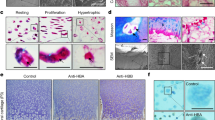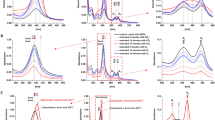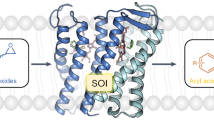Abstract
A molecular description of haemoglobin's cooperative oxygen binding and release was founded on the X-ray crystal structures of the deoxy-T and oxy-R states1–3. Since the R state's oxygen affinity is close to that of an isolated subunit, the crucial allosteric phenomena are (1) the reduced affinity of the T state and (2) the kinetic pathway between the two quaternary structures. To investigate these phenomena directly, we have determined at high resolution (dmin = 2.1 Å) the crystal structures of two liganded T-state haemoglobins. In the liganded T-state α subunit, both the tight packing of the haem and the intersubunit contacts inhibit a conformational change between the F helix and FG corner which would allow the haem to become planar and the iron to assume symmetrical R-like coordination. In the β subunit, by contrast, we find no strain on the proximal side, but the intersubunit contacts prevent the haem from tilting about an axis parallel to the F helix which would open up the binding site to oxygen. In both subunits, ligand binding in the T state induces structural changes towards the tertiary conformation of the R state.
This is a preview of subscription content, access via your institution
Access options
Subscribe to this journal
Receive 51 print issues and online access
$199.00 per year
only $3.90 per issue
Buy this article
- Purchase on SpringerLink
- Instant access to full article PDF
Prices may be subject to local taxes which are calculated during checkout
Similar content being viewed by others
References
Perutz, M. F. Nature 228, 726–739 (1970).
Monod, J., Wyman, J. & Changeux, J-P. J. molec. Biol. 12, 88–118 (1965).
Baldwin, J. & Chothia, C. J. molec. Biol. 129, 175–195 (1979).
Haurowitz, F. Z. physiol. Chem. 254, 266–274 (1938).
Anderson, L. J. molec. Biol. 79, 495–502 (1973).
Derewenda, Z. et al. in Proceedings of the Haemoglobin Symposium Faculte des Sciences Universite de Bruxelles (ed. Schnek A. G. & Paul, C.) 52–67 (Edition de l'Université de Bruxelles, Bruxelles, 1983).
Brzozowski, A. et al. Nature 307, 74–76 (1984).
Ward, L. B., Wishner, B. C., Lattman, E. E. & Love, N. E. J. molec. Biol. 98, 161–171 (1975).
Fermi, G., Perutz, M. F., Shaanan, B. & Fourme, R. J. molec. Biol. 175, 169–171 (1984).
Gelin, B. R. & Karplus, M. Proc. natn. Acad. Sci. U.S.A. 74, 801–805 (1977).
Shaanan, B. J. molec. Biol. 171, 31–51 (1983).
Warshel, A. & Weiss, R. J. Am. chem. Soc. 103, 446–451 (1981).
Fermi, G. J. molec. Biol. 97, 225–256 (1975).
Agarwal, R. C., Lifchitz, A. & Dodson, E. J. in Refinement of Protein Structures; ‘Proceedings of the Daresbury Study Weekend’ November 1980 (eds Campbell, J. & Machin, P.) 36–39 (Science and Engineering Research Council, Daresbury, 1980).
Derewenda, Z. S., Dodson, E. J., Dodson, G. G. & Brzozowski, A. M. Acta. crystallogr. A37, 407–413 (1981).
Jack, A. & Levitt, M. Acta crystallogr. A34, 344–350 (1980).
Konnert, J. H. & Hendrickson, W. in Computing in Crystallography (eds Diamond, R., Ramaschan, S. & Venkatasan, K. 13.01–13.23 (Ind. Inst. Sci., Bangalore, 1980).
Gelin, B. R., Lee, A. W-M. & Karplus, M. J. molec. Biol. 171, 489–559 (1983).
Author information
Authors and Affiliations
Rights and permissions
About this article
Cite this article
Liddington, R., Derewenda, Z., Dodson, G. et al. Structure of the liganded T state of haemoglobin identifies the origin of cooperative oxygen binding. Nature 331, 725–728 (1988). https://doi.org/10.1038/331725a0
Received:
Accepted:
Issue date:
DOI: https://doi.org/10.1038/331725a0
This article is cited by
-
Molecular susceptibility to glycation and its implication in diabetes mellitus and related diseases
Molecular and Cellular Biochemistry (2010)
-
Enzymatic Catalytic Spectrophotometric Determination of Thiamine in Food
Food Analytical Methods (2010)
-
Is cooperative oxygen binding by hemoglobin really understood?
Rendiconti Lincei (2006)
-
Allosteric transition intermediates modelled by crosslinked haemoglobins
Nature (1995)
-
Crystals of haemoglobin with the T quaternary structure bind oxygen noncooperatively with no Bohr effect
Nature (1991)



